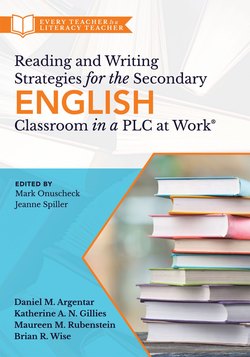Читать книгу Reading and Writing Strategies for the Secondary English Classroom in a PLC at Work® - Daniel M. Argentar - Страница 11
На сайте Литреса книга снята с продажи.
ОглавлениеCHAPTER 2
Foundational Literacy Triage
Throughout this book, we focus on how to establish a culture of literacy in the English classroom as well as how to establish a literacy focus throughout the school. As educators committed to learning, we all need to recognize the value of literacy, and we all need to celebrate the results when a whole school establishes goals and creates an environment for students to feel safe when learning and attempting literacy strategies. However, this process takes time, and more often than not, we have teachers come to us who need immediate assistance. They have specific students, classes, projects, or assignments they are struggling with, and they need a strategy or way to help the students now.
Always keep in mind the array of learners in your classroom. When instructing students in a mainstream classroom, there will certainly be a range of different student learning proficiencies within each class. Further, students’ reading levels may be even more diverse, and among these reading levels, you will have students with special education needs (emotional, learning, or medical), students with 504 plans, and students who are only just learning English. As an ELA teacher, you will need to meet the individual needs and developing potential of all the students in your classes.
We have seen that teachers often begin to notice concerns related to literacy early in the year and look for differentiated instructional ideas to meet student needs. This chapter helps you identify ways to triage literacy within an English classroom immediately and work with the variety of student needs and abilities your classroom contains. We cover the basics of RTI practices, differentiated instruction, assessment of text complexity, and several “fix-up” strategies to assist students when reading a text (Tovani, 2000). We close by examining factors to consider when supporting struggling students and for further advancing students who show proficiency.
Understanding Response to Intervention
RTI, also referred to as MTSS, is a three-tiered systematic process for ensuring the time and support students need in order to learn at high levels. Austin Buffum, Mike Mattos, and Janet Malone (2018) explain, “Tier 1 represents core instruction, Tier 2 represents supplemental interventions, and Tier 3 represents intensive student supports” (p. 2).
